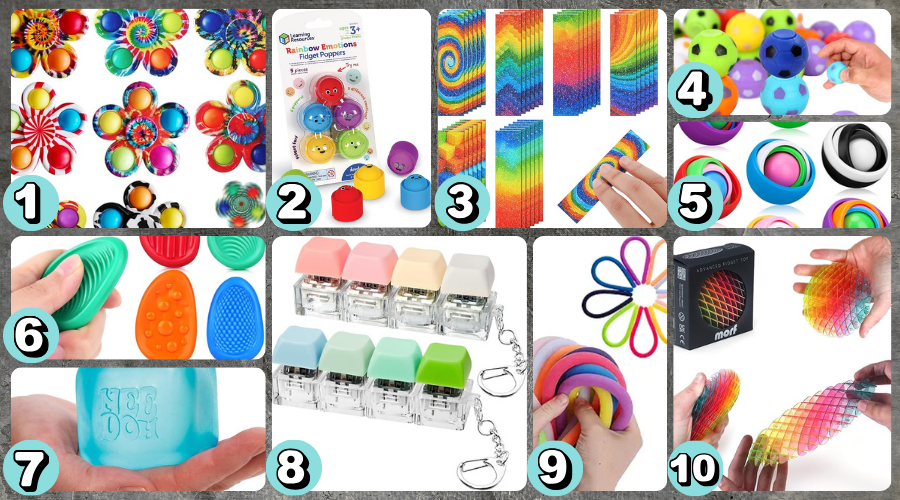Spin, Pop, Squeeze: How Fidgets Support Learning
Nov 02, 2025
Fidgets have become a familiar part of many routines, from therapy and homeschool activities to outings, travel, and day-to-day life — and for good reason. They’re small tools or objects that help our students focus, regulate energy, and stay engaged during learning. A “fidget” might look like a spinner, a squishy, a stretchy band, or even a smooth stone — but at its core, it’s simply an outlet for movement and sensory input.
What Is a Fidget?
A fidget is any object that can be held, squeezed, twisted, or manipulated in a repetitive way. For some learners, this rhythmic motion helps the brain stay alert and the body grounded. Fidgets aren’t distractions — they’re supports. They give busy hands something purposeful to do while the mind works on a task.
Researchers have found that providing students with access to small, hand-held fidget tools can improve on-task behavior in some contexts, particularly for learners with ADHD or sensory regulation needs. Other studies suggest the benefits depend on how and when the tools are used.
Why Fidgets Are Important
Movement plays a key role in self-regulation. Many autistic and neurodivergent students rely on movement to process information, calm their bodies, and maintain attention. When that movement is limited — such as during seated learning — focus can become more difficult.
Fidgets allow that movement to happen in small, acceptable ways. They offer tactile feedback and gentle stimulation, helping a student self-regulate without disrupting the environment. For nonspeaking students, fidgets can also support emotional regulation before or after communication sessions or AAC activities.
Families of autistic children often report that fidgets help their child concentrate and reduce anxiety by satisfying sensory needs. While every learner is unique, these small tools often serve as an effective bridge between sensory input and learning readiness.
Finding the Right Fit
Many of our learners thrive when they have the freedom to move, explore, and make sensory choices that feel right to them. In a homeschool setting, fidgets don’t need to be “quiet” or hidden — they can be colorful, textured, or even a little noisy if that’s what helps your student stay engaged. The goal is to provide options that meet your child’s sensory needs in a way that feels natural and enjoyable, not restrictive.
Not every fidget will be a perfect fit, and that’s perfectly fine. Some learners prefer soft, squeezable textures; others seek something firm, clicky, or stretchy. The goal isn’t to find the “trendiest” gadget, but the one that supports focus and comfort. Try a few options, observe your student’s reactions, and let them guide the process. Sometimes, the best “fidget” isn’t even a store-bought product — it might be a pencil topper, a fabric swatch, or a bracelet that feels soothing to touch.
A Gentle Reminder
Fidgets are tools, not tests. Their value isn’t measured by how long a student uses one or how still they appear. The goal is comfort, presence, and participation.
If a fidget helps your student stay calmer, more focused, or more willing to engage — it’s doing its job.
From Our Home
I am always on the lookout for fidgets that my daughter will find useful. She’s enjoyed poppers (we have a couple only used for car rides); spinner-and-popper combos; and an orbiting spinner ball, to name a few. We have all sorts around the house that are either used in the way they were designed to be used — or just as play objects, which is fine too. What matters most is that she has tools that fit her needs and bring her joy.
Every learner benefits from accessible, sensory-friendly tools that support how their brain learns best. Try a few fidgets this week, observe what works, and celebrate the small moments of focus and calm along the way.
Need some fidgets to try?

(Note, these examples are colorful! Some items come in other patterns/colors.)
- Rainbow spinner+popper combo [Amazon]
- Learning Resources Rainbow Emotion Fidget Poppers [Amazon]
- Rainbow Style Anxiety Sensory Stickers [Amazon]
- Mini Fidget Spinner Soccer Ball [Amazon]
- Gyroscope Ball [Amazon]
- Textured Soft Stones [Amazon]
- NeeDoh Nice Squeeze Cube [Amazon]
- Keyboard Fidget Toy [Amazon]
- Monkey Noodle Fidget [Amazon]
- Morf Fidget Worm [Amazon]
References
-
Using Fidget Spinners to Improve On-Task Classroom Behavior for Students with ADHD — increases in on-task behavior observed in some contexts (pmc.ncbi.nlm.nih.gov)
-
The Effect of the Fidget Cube on Classroom Behavior — mixed or null effects across studies (pmc.ncbi.nlm.nih.gov)
-
Evaluating the Evidence for Fidget Toys in the Classroom — systematic review on fidget tools and learning outcomes (journals.sagepub.com)
-
Parental perspectives on the use of fidget toys in autistic children — reported benefits in concentration and anxiety relief (link.springer.com)
-
Fidget Toys and Autism: How Do They Help? — overview of sensory regulation and calming benefits (goldencaretherapy.com)
-
Fidgets and ADHD: A Focus Tool or a Toy? — OT guidance for choosing discreet fidgets (ot4adhd.com)
-
Fidget Spinners: Purported Benefits, Adverse Effects, and Accepted Science — summary of cautionary findings (pubmed.ncbi.nlm.nih.gov)

Jennifer Bullock, Contributing Author
Homeschooling-experienced mom to a tween, non-speaking daughter, Jennifer is also Marketing Outreach Coordinator for The Autism Oasis. With 20+ years experience in marketing, advertising, and social media communications, you will see her occasionally supporting the blog and social media channels with various content related to Autism Oasis.
Nonverbal Autism Homeschool enrollment is currently open!
Stay connected with news and updates!
Join our mailing list to stay updated on Nonverbal Autism Homeschool courses, special events and new blog posts. You'll also receive free curriculum, inspirational messages, autism parenting hacks and more!
We hate SPAM. We will never sell your information, for any reason.

